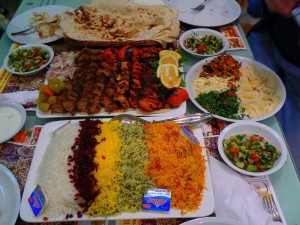Boy oh boy, is it time for blog post number two already?!
Well, for the past two ASTU classes, we have been discussing Persepolis by Marjane Satrapi in relation to its genre. The book is a “graphic narrative”, you could look at it as a kind of morph of a graphic novel and autobiography. It is not a graphic novel in that is it simply not a novel, but it is not just an autobiography because the illustrated aspect of the book plays such a key role in relaying Satrapi’s story to the reader. In fact, that is exactly what this post is going to focus on.
Why did Satrapi choose to tell her story in the form of a graphic narrative? What are the advantages of publishing a comic book over a generic autobiography?
For starters, comic books are generally easily accessible and quick reads; that is to say, there is not a lot of thought or effort that goes into reading a comic book, versus say a 200 page autobiography. Considering her topic, a comic book is a great vehicle to get her story into the cultural mainstream. She is telling a story of her childhood growing up in Iran, a topic that many people in the Western world know nothing about, so to deliver it in a way that is very comprehensible, accessible and in many ways relatable for all readers is a brilliant strategy. Not only that, but throughout the entire book she plays with the juxtaposition of war and terror with child naivety and humor which would be difficult to portray through a written autobiography.
Take for instance page 133.
Here is an example of a serious event that she is able to depict with humor. The two women are part of the women’s branch of the Guardians of the Revolution and they had the right to arrest Marji because she was improperly veiled. On the next page, she explains that if she were to be arrested, they would have the right to detain her without notifying her parents and torture her; anything is fair game. But despite it being a serious incident, Satrapi uses humor to recount the event. For instance, one of the women calls her shoes punk and as the narrator Marjane notes, “it was obvious that she had no idea what punk was”. Not only is her narration witty and sassy, so are her retaliations in the speech bubbles. When one of the women comment on her tight jeans, she quickly repsonds, “they shrank!!” I found this page to be really funny despite the fact that it is depicting a very serious issue for many women of that time.
Throughout the book, Satrapi expertly utilizes humor as a tool for conveying very heavy themes and it poses a very fascinating juxtaposition and makes for a very interesting read.
On a slightly unrelated note, what also struck me on this page and in a couple of other places throughout the book (particularly pages 93 and 74) was the use of the word “whore”. Marji was just a teenager and she was classified as a whore based on her veil positioning. The words “whore” and “slut” are tossed around loosely in this book to describe women who don’t follow the dress codes and that is a very mature concept for a child to understand – not only to understand but also deal with being called one.



